ORDER NEW COPY OF MSL502 LEADING AND BUILDING HIGH PERFORMING TEAMS ASSIGNMENT & GET HIGH QUALITY SOLUTIONS FROM SUBJECT'S TUTORS!
MSL502 Leading and Building High Performing Teams Assignment - Abu Dhabi University, UAE
Research Paper - Develop the LITERATURE REVIEW section.
TOPIC - The Micro Foundations of the Entrepreneurial Team: A Study
The purpose of a Literature Review is to summarize what you have learned from an immersion in the research literature related to your problem statement. The written literature review is an organized narrative that conveys to the readers of your action research project the relevance of published research to your problem statement.
Answer - The Micro foundations of Entrepreneurship team: A study
Abstract
The research is focused on exploring the micro foundation of entrepreneurial team by evaluating the influence of numerous micro and macro variables in team work, team effectiveness as well as team collaboration. The research is discussed about the entrepreneurship and micro foundations of dynamic competences. Even with an increasing interesting in both administrative progressive skills and the micro-level foundations of practices and abilities researchers know comparatively little about how administrators and their distinct procedures interrelate with the development of administrative competences. The research has been done through positivism research philosophy, descriptive research design and deductive approach. Only primary data collection method was used in this research. For the teamwork, both the leaders have scored above average, therefore it can be said that both of them are very efficient leaders. It has been identified that the every factors have a mild influence in the success of team effectiveness.
Chapter 1: Introduction
1.1 Introduction
New firm construction is a major aspect in improving financial performance as a mechanism for enhancing sector productivity, familiarising innovation, and job formation. In the viewpoint of Helfat & Peteraf (2015), the procedure of team adaptation is vital for group success as usefulness in today's workstation confide upon teams that are flexible and progressive in the unescapable presence of change. In the opinion O'Brien et al. (2019), of a considerable quantity of work has been accompanied on the positive characteristics of a team's adaptation procedure. The research is discussed about the entrepreneurship and micro foundations of dynamic competences.
1.2 Back ground of the study
The capacity of an association to successfully adjust and meet the requirements of a changing environment is reliant on managerial dynamic competences. These capabilities characteristically exist in the top administration team of the organization and they permit these entrepreneurial executives to sense and frequently form the future evolutionary appropriateness of the firm. In the opinion of Randolph-Senget al. (2015), like several social decisions, the choice to become an entrepreneur is moulded and swotted given the set of facts available to the separate. In the opinion of O'Brien et al. (2019), different managers have different evidence, thus different insights about the improbability and price related with becoming an entrepreneur. On the other hand, uncertainty, in the sense of uninterrupted change, is the entrepreneurial environment, whereas greater attentiveness and the capacity to manage with improbability are the fundamental characteristics of the entrepreneur.
ORDER NEW MSL502 LEADING AND BUILDING HIGH PERFORMING TEAMS ASSIGNMENT AT NOMINAL PRICE!
1.3 Aim of the research
The aim of the research is to focus on exploring the micro foundation of entrepreneurial team by analysing the influence of various micro and macro variables in teamwork, team efficacy as well as team interaction.
1.4 Rationale of the study
Understanding commercial construction has been expressively improved by the development of longitudinal trainings of the entrepreneurial practice. In the opinion of Roundy & Fayard (2019), entrepreneurship is one of the fundamentals in social action that is suitable with the path of time, that makes stuffs happen, and that produces change. Thus, the market procedure is a progressive practice of change driven by aware entrepreneurs who realize new profit prospects. Today, however, even with an increasing interesting in both administrative progressive skills and the micro-level foundations of practices and abilities researchers know comparatively little about how administrators and their distinct procedures interrelate with the development of administrative competences.
Chapter2: Literature review
2.1 Introduction
Literature review is a very essential part of the research as it helps the research in order to understand the study properly. In this chapter, the researcher will discussed about concept of team effectiveness, team adaptation and maladaptation, components of team effectiveness, necessity of teamwork and effective model of team adaptation and development. The study will help the researcher to get clear idea about the topic.
2.2 Concept of team effectiveness
Teamwork manners were associated to team-efficacy, which was connected to team performance. In the opinion of Hu & Liden (2015), team effectiveness and performance is encouraging yet more desires to be done to deliver sturdy evidence for the association. Proper training procedure can help to improve the knowledge and skill of the employees as well as improve the team effectiveness. In order to build an efficient team, a team leader requires establishing an administrative environment in which the group of employees can initiate self-reflection and evaluate the relationship with other group members. In the opinion of Hajro, Gibson &Pudelko(2017), the effective team has clear and understandable idea, strategy, goals, action including common focus and path to achieve the success. In the viewpoint of Hu &Liden (2015), the improvement of high-performance group takes the united determinations of idealistic leaders and motivated group members. In the effective team, every member of the group has clearly defined expectation, plan, and target of the other group member. On the other hand, effective team has the ability to utilize both external and internal resources of the organization.
GET BENEFITTED WITH QUALITY MSL502 LEADING AND BUILDING HIGH PERFORMING TEAMS ASSIGNMENT HELP SERVICE OF EXPERTSMINDS.COM!
2.3 Concept of team adaptation and maladaptation
Team adaptation is a procedure in which a team requires to change for their betterment. In the viewpoint of Frick et al. (2018), team adaptation and the developing nature of adaptive group presentation are distinct from a multilevel, theoretical perspective. Team adaptation can be defined as the change in the group performance in reaction to a significant indication, that leads to functional consequence for the whole group member. In the opinion of Ceri-Booms, Curseu&Oerlemans (2017),team adaptation procedure is very essential in order to achieve success in effective way. On the other hand, maladaptation during the response phase can be very harmful. In order to execute the adaptation process the organization can follow the four R's. Four R's includes recognize, respond, reframe and reflect (Maynard et al., 2015).
2.4 Components of team effectiveness
There are some components of effective team described in the below section:
Positive commercial culture- in order to introduce long-term operative group members, the commercial culture of the administration must be positive, revitalizing and transparent.
Recognition process- recognition process can enhance the motivation of the group member and enhance the inspiration to give their level best (Reis & Puente-Palacios, 2019). Award of outstanding performance can be given to those who work beyond expectation. Continued performance tag can be given to those who continuously improving in their commitments, work and responsibilities. The tag of improved performance can be given to the employees who trying to increase their performance.
Provide opportunities- in order to retain the effective employees the organization must provide new opportunities to the employees for enhancing staff satisfaction rate.
Positive feedback- feedback from the team leader is very essential for the employees as they can realize and recognize their working result. Without positive and negative feedback the group member will unable to understand their performance (Reis & Puente-Palacios, 2019). Feedback can be given in both informal and formal way.
2.5 Necessity of team work
Teamwork is very essential in order to improve the relations between the employees and between employees and team leader. In the opinion of Lacerenzaet al. (2018), effective teamwork helps to reduce the unnecessary conflict that may arise among the group members who try to do their best in order to perform well. On the other hand, efficient group wok provides the organization more productivity and accuracy on the work. Tram work process helps to enhance collaboration and it allows the brainstorming process that is beneficial for the group member as well as for the organization. In the viewpoint of Tripathy (2018), two or more than two people are more efficient than one people to solve any problem, increase creativity and enhance productivity. In the team, each member can gain knowledge and skill from other team memberthus, teamwork provide opportunity of learning. Moreover, effective teamwork motivate other employees and improve unity in the workstation.
SAVE TOP GRADE USING MSL502 LEADING AND BUILDING HIGH PERFORMING TEAMS ASSIGNMENT HELP SERVICE OF EXPERTSMINDS.COM!
2.6 Model of team development
In order to develop an efficient team the organization can follow the Tuckman's steps of team development. There five stages in the model that are described in the following section:
Forming-in this stage the team member is nervous and anxious as they do not understand the task properly (Jones, 2019). In this step, the team leader has to act dominantly to clear the responsibility and role of the employees.
Storming- In second stage the employees start to push against the restrictions introduced in the first stage. In storming stage, conflict between group member regarding working style happen.
Norming-In this stage employees start to solve their differences. The team starts to collaborate, socialize with each other and ask for help and provide significant feedbacks (Jones, 2019).
Performing- In this stage the group member work with effectiveness in order to achieve the goal and target.
Adjourning- Team eventually reach this stage. This phase is known as mourning because workers have grown adjacent and feels a loss that the experience is finished.
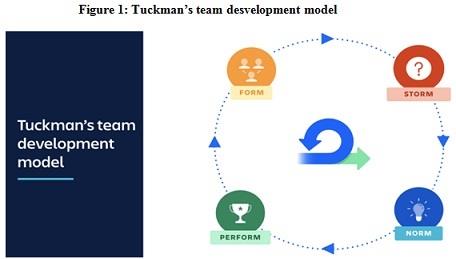
2.7 Model of team adaptation
The four R's model can be applied in order to monitor the team adaptation process and the maladaptation, which may occur during the phase of responds. The model consists four phase of adaptation that are respond, recognize, reframe and reflect.
Recognize-In this recognition phase the group members use evidence collected from both external and internal environmental indication in order to evaluate the current situation and recognise the need for change. In the opinion of Frick et al. (2018), this is the beginning of the adaptive procedure, whereby at least one employee of the group examines the environment to find indications that may affect the team's effort and allocates significance to these indications.
Reframe- In this stage the group members organise to respond to the recognized indications by changing their course of act. In the opinion of Lei et al. (2016), reframing, in an adaptive perspective, is the procedure of allowing stimuli in the exterior and interior environment as well the resources of the group in diverse way.
Respond- After recognize and reframe the indication the team employees formulate the high quality respond in order to enhance their performance. In the viewpoint of Frick et al. (2018), respond phase includes some action that are construct of communication, mutual observing, back-up behaviour and synchronisation.
Reflect-Reflect is the last stage of four R's model. In the opinion of Frick et al. (2018), the stage reflects the adaptive cycle prepared by the group member and the primary recognition of the indication in the interior or exterior environment, how the members reframed and responded the identified indications and as a final point, how the response of the group member affected performance of the team.
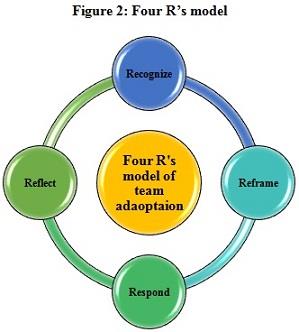
DO YOU WANT TO EXCEL IN MSL502 LEADING AND BUILDING HIGH PERFORMING TEAMS ASSIGNMENT - ORDER AT EXPERTSMINDS!
2.8 Conclusion
The effective team has clear and understandable idea, strategy, goals, action including common focus and path to achieve the success. It can be said that team adaptation is a procedure in which a team requires to change for their improvement. On the other hand, efficient group wok provides the organization more productivity and accuracy on the work. Tuckman's model of team development helps the organization to develop an efficient team. On the other hand, it is seen that four R's model can help to monitor the team adaptation process and also find out the maladaptation occur during the respond.
2.9 Conceptual Framework
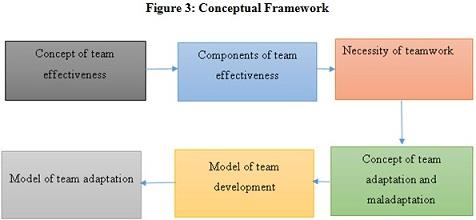
Chapter 3: Methodology
This chapter is very important as it builds the framework required for the successful conduction of the research. It identifies the techniques required for different elements embedded in the research outline, including research philosophy, design and methods of data collection and analysis. The research objectives have also been specified in this chapter.
3.1 Research outline
Research outline can be referred to as the blueprint of a research work containing the highlights of the plans associated with the main task of the study (Kumar, 2019). A good research outline increases the efficiency involved with the research. In this study, the research onion has been chosen as the appropriate research outline, as it simply and clearly projects the elements involved through a pictorial representation. This has been shown in the figure below.
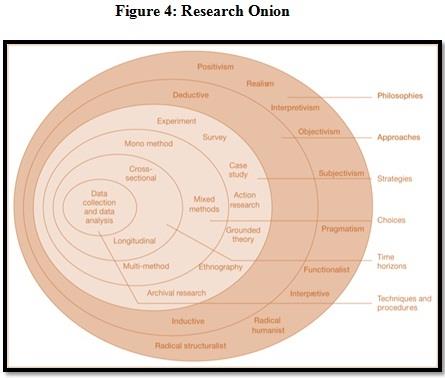
3.2 Research philosophy
Research philosophy captures the quality of thoughts regarding how truth is embedded within a research. The knowledge of truth is captured by the epistemology, while doxology captures what is believed to be true. These two aspects have given rise to the three types of research philosophies that had been considered for the research and one had been finally selected. Realism research philosophy alienates the idea of reality from the human mind. Direct realism is associated with the portray of the world through human senses while critical realism regards human senses as deceptive and not dependable for uncovering the real truth (Padilla-Díaz, 2015). Both the schools form extremes. Interpretivism research philosophy is concerned with explanation of the elements embedded with the study from definite perspectives. It does not adopt scientific approach and is not suitable for quantitative analysis. Positivism research philosophy adopts scientific methods of data gathering and analysis and is suitable for both quantitative and qualitative analysis. It does allow some level of human behaviour when it comes to the explanation of the inferences of data analysis. The most dependable part of the philosophy is that it follows a very well defined structure that makes it easier to comprehend the steps involved with the research. Positivism philosophy has been chosen for the study.
HELPING STUDENTS TO WRITE QUALITY MSL502 LEADING AND BUILDING HIGH PERFORMING TEAMS ASSIGNMENT AT LOW COST!
3.3 Research approach and Research objectives
The research approach entails the broad assumptions that are incorporated in a research. Research approach can be segmented into two parts: inductive and deductive. When it comes to inductive approach, the research data are collected at the beginning and the researcher's task is to find a specific pattern that is hidden within the data, after which the research hypotheses are generated. These hypotheses are temporary, based on which the theory is built. For deductive approach, the journey is quite the opposite. The study begins with theories or models that already existing and builds the research hypotheses on the bases of the objectives of the research (Tjora, 2018). This is followed by the data collection and their analysis followed by the confirmation whether the research hypotheses are ejected or accepted. In this study there is no need for building new models or coming up with new theories, which is why deductive approach has been considered suitable. The approach would be directed towards fulfilling the following objectives.
1. To identify the elements required to achieve team effectiveness
2. To understand the needs of the individual team members
3. To evaluate the activity level amongst team members
4. To find out how well the team member are involved with social interaction
3.4 Research design
The research design refers to the general plan adopted for the methods and techniques to be used in the research. There are primarily three types of research design: descriptive, exploratory and explanatory. Exploratory research design involves a search for something undiscovered and explore, as the name suggests. Explanatory is just the opposite of exploratory. It does not deal with something new but things that have been less researched on. It is at the juncture between explanatory and exploratory research design that descriptive research design finds a unique place (Edmonds & Kennedy, 2016). It is an effective design for the purpose of analysing non-quantified topics, which means that it can deal with qualitative data. It is also good at handling quantitative data, while the other two are good at either of the two. Therefore, descriptive research design has been regarded as the most suitable out of the three for the current study.
3.5 Data collection and analysis
Data collection can be of two types. The first type is primary data that is directly collected by the researcher from the field. Secondary data is collected from other sources where the primary research has already been conducted. These sources could be government websites, books, articles, journals, magazines or annual report. In this study, only primary data has been considered. Primary data can be in the form of surveys or in the form of interviews (Almalki, 2016). The data collection consists of the responses of two team leaders, Noura and Shaima based on teamwork assessment and FIRO-b. A detailed questionnaire was provided, where the answers carried different weights, and the end evaluation had thrown light on various aspects of team work and team performance that would be discussed later.
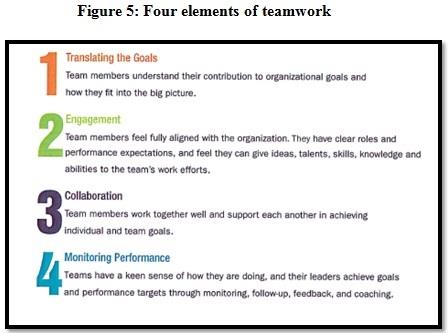
The above figure shows the four elements of teamwork captured in the data collection. Each of the four elements consisted of 10 questions where the respondent had to rate from 1 to 4 based on the frequency of demonstrating the individual behaviour, 1 referring to never demonstrating and 4 referring to almost always demonstrating a particular behaviour. These elements are related with the individual and team contributions leading to the achievement of the organisational goals, as shown in the figure below.

Fundamental Interpersonal Relationships Orientation behaviour (FIRO b), on the other hand refers to the behavioural aspects of leader handling a team. There are three main elements considered here: inclusion referring to the importance of people, control referring to assuming responsibility and affection referring to the importance of affection. All the three elements can further be expressed in two ways: how much of the behaviours are actually expressed and how much of it is wanted. The expressed set of elements (expressed inclusion (EI), expressed control (EC) and expressed affection (EA)) together forms the activity level, while the wanted set of elements (wanted inclusion (WI), wanted control (WC) and wanted affection (WA)) together form the need level (Ditchburn & Brook, 2015). The sum of need and activity levels forms the social interaction index. The weights of the questions have been used in forming 6 tables to arrive at the final results.
WORK TOGETHER WITH EXPERTSMIND'S TUTOR TO ACHIEVE SUCCESS IN MSL502 LEADING AND BUILDING HIGH PERFORMING TEAMS ASSIGNMENT!
3.6 Ethical consideration
The data have been collected only after ensuring that they have the full idea of what the results would be used for and they have participated willingly. There was no bribe or other incentive provided for the participants to answer the questionnaires. They were also ensured that the participation would cause no harm to them in their personal and professional lives as well.
3.7 Research timeline
Table 1: Gantt chart
|
Steps taken for controlling the research
|
1st Week
|
2nd Week
|
3rd Week
|
4th Week
|
5th Week
|
6th Week
|
7th Week
|
|
Deciding the final research topic
|
*
|
|
|
|
|
|
|
|
Going through various books and journal articles in order to successfully complete the Literature Review.
|
|
*
|
|
|
|
|
|
|
Completing the development of research methodology
|
|
|
*
|
|
|
|
|
|
Conducting the survey
|
|
|
|
*
|
*
|
|
|
|
Analyzing the results and interpreting them
|
|
|
|
*
|
*
|
|
|
|
Deciding on the findings
|
|
|
|
|
|
*
|
|
|
Concluding the research and providing recommendations for the associated parties
|
|
|
|
|
|
*
|
*
|
|
Final submission of the research report
|
|
|
|
|
|
|
*
|
DO YOU WANT TO EXCEL IN MSL502 LEADING AND BUILDING HIGH PERFORMING TEAMS ASSIGNMENT? HIRE TRUSTED TUTORS FROM EXPERTSMINDS AND ACHIEVE SUCCESS!
Chapter 4: Results & Discussions
4.1 Data Findings
Teamwork
Referring to the figures in the appendix for translating the goals, it can be seen that Noura and Shaima had scored 36 and 35 respectively, which are pretty high scores, given that the highest possible score is 40. From the above figures for engagement from the appendix, it can be seen that the leaders are associated with a high level of interaction. Shaima's score is very high compared to that of Noura, as they have scored 35 and 31 respectively. The data from the appendix with two questionnaires related to collaboration show that Noura has scored 33, while Shaima has scored 37 in collaborating with teams. Shaima has again scored more than Noura.
It can be gathered from the above two tables that both the leader respondents have been very efficient at monitoring performance. Both are at par with each other with a score as high as 37.
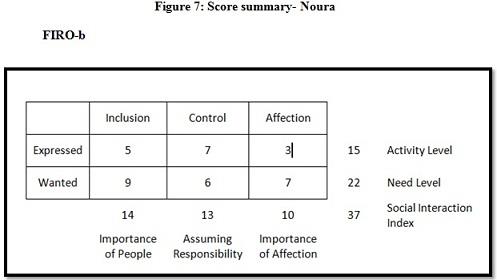
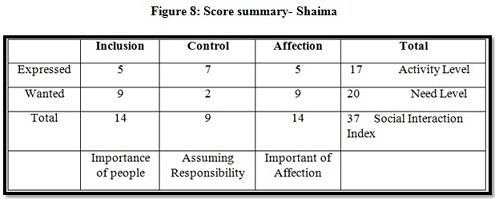
The above two figures represent the summary scores of both the leaders in FIRO b framework. The two leaders are competent, however there are certain areas that they need to improve, that would be covered in the section. EI, EC and EA for Noura are 5, 7 and 3 respectively. Shaima's wanted scores in the order WI, WC and WA are 9, 2 and 9 respectively. Based on these data, the activity level and need level have been derived for both the leaders. The activity level for Noura is 15 and Shaima is 20. The need level for Noura and Shaima are 22 and 20 respectively. Both have the same score, 14, for importance of people, while for assuming responsibility, Noura has scored 13 and Shaima has scored 9. Noura has scored 10 in importance of affection and Shaima has scored 14. The total social interaction for both of them is same with a score of 37.
The total summary of the research results has been shown below, which would lead to the next section, data analysis.

GET ASSURED A++ GRADE IN EACH MSL502 LEADING AND BUILDING HIGH PERFORMING TEAMS ASSIGNMENT ORDER - ORDER FOR ORIGINALLY WRITTEN SOLUTIONS!
4.2 Data analysis
Based on the above given data, it can be stated that behaviour (social interaction) and teamwork are the two major micro-foundation of entrepreneurial teams. The first objective of this study is to find out the elements to achieve team effectiveness. Based on the data analysis, it can be stated that these elements are translating goals (TG), engagement (ENG), collaboration (CB) and monitoring performance (MBP). It can be linked with the findings of the literature review, where it has been suggested that the main elements are positive team culture (done by translating goals), recognition (done by increasing engagement), providing opportunities (done by increasing collaboration) and feedback (done by monitoring performance). It has been analyzed that increasing engagement and collaboration are the two most challenging aspect of team effectiveness. It can be interpreted that Noura clearly faced some issues in these two aspects. Hence, in order to increase effectiveness of entrepreneurial teams, these two elements can be considered as most significant.
Based on the comparison conducted between wanted and expression of Fairo-B analysis, it can be stated that team members have to face some major challenges to attain some factors. From the above given data it has been found that both the members had to face issues regarding inclusion and affection. Both of them scored average in these two aspects. However, both them are able to perform excellently in terms of control. One of the objectives of this study is to find out the involvement level of team members in terms of social interaction. Though the social interaction values are same, the leaders are different. In terms of activity level,Noura has medium interaction with 15 and so does Shaima with score 17. That means Shaima has slightly better activity level compare to Noura, which meets the third research objective of the study. This data indicates the fact that, activity level of team members can increase their effectiveness within a team. Despite of same social interaction level, Shaima can be considered as more effective team member compare to Noura due to higher activity level. Hence, all team members need to focus on improving activity level within an entrepreneurial team. It has also been found from the literature review section that through high activity level, team members can gain knowledge and skill from other team member. It can increase creativity, enhance productivity and collaboration.
Chapter 5: Conclusion and Recommendation
5.1 Conclusion
The respective research paper has been most successful to point out the micro-foundation variables, which are largely influential in the context of entrepreneurial team. It has been identified that the every factors have a mild influence in the success of team effectiveness. However, the inclusion and affection field of team is largely challenging. As an entrepreneurial team encompasses several diverse entities, the attainment of overall inclusion and affection among the team members is very challenging. The team exhibits average score in activity, which emphasizes the need of fun activities among the time. The team has been noticed to be well involved in social interaction.
24/7 AVAILABILITY OF TRUSTED MSL502 LEADING AND BUILDING HIGH PERFORMING TEAMS ASSIGNMENT WRITERS! ORDER ASSIGNMENTS FOR BETTER RESULTS!
5.2 Recommendation
The research has been highly effective to identify several areas, which needs proper recommendation to be improved. The following discussion provides several suggestion, which will be imperative in team efficacy.
Open Communication: The contemporary entrepreneurial teams need to focus on open communication among the team members. It is highly essential to improve the team inclusion and affection.
Fun activities: The teams need to arrange more fun activities, such as quiz, sports events; so that the inclusion and affection among the team members can be increased. Moreover, it is a very unique way to diversify the activities of team members.
Team Gathering: The team must encourage the team members to get together social events such as team party, birthday celebration etc. It is a very important technique to improve the social interaction among the team members.
5.3 Limitation of the research
The effectiveness of the research has been constrained by a number of factors that can be segmented broadly into time and cost or budget. A lot of meaningful insights could be gained if the managers of the organisations could be interviewed. A survey could be done on more people. Two people cannot represent an entire population of team members. However, more people could not be involved as it cross the budget and would take more time to complete. The research paper has not been able to collect data from a large number of participants. Therefore, it has severely hindered the reliability of the entire research. At the same time, the research work has not been able to collect the perspective of team leaders and managers, which would have been helpful for attaining diverse view on the subject matter.
5.4 Implication of the study
The research has been able to pave a crucial path in the context of attaining a complete insight on the entrepreneurial team. The future research will be able to highlight more variables in regards to the micro-foundation of entrepreneurial team. The research path will be greatly helpful in conducting the business work in future. Moreover, the research will be highly effective in helping team leading in any field.
SAVE DISTINCTION MARKS IN EACH MSL502 LEADING AND BUILDING HIGH PERFORMING TEAMS ASSIGNMENT WHICH IS WRITTEN BY OUR PROFESSIONAL WRITER!
Avail the best Abu Dhabi University, UAE Assignment Help Service For Different Other Courses, Such As:-
- MSL500 Strategic Dimensions of Business Functions Assignment Help
- MSL501 Developing a Leader Within You Assignment Help
- MSL503 Contemporary Issues in leadership Assignment Help
- MSL513 Negotiation and Conflict Resolution Assignment Help
- MSL514 Organizational Behavior Assignment Help
- MSL522 Leadership and Communication Assignment Help
- MSL524 Research Methods in Business Assignment Help
- MSL525 Leading Organizational Change Assignment Help
- MSL561 Cross-Cultural Management Assignment Help
- MSL599 Project in Leadership Assignment Help